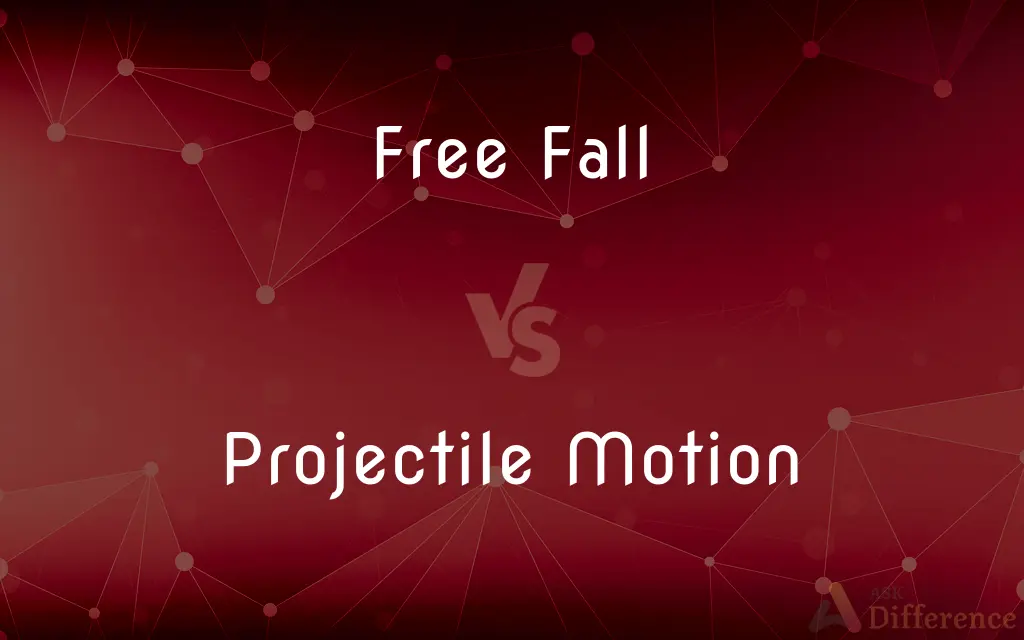Free Fall vs. Projectile Motion — What's the Difference?
By Tayyaba Rehman — Published on January 30, 2024
Free Fall is the motion of an object solely under gravity's influence, while Projectile Motion involves an object thrown into the air, moving under gravity and initial velocity.

Difference Between Free Fall and Projectile Motion
Table of Contents
ADVERTISEMENT
Key Differences
Free Fall refers to the motion of an object under the sole influence of gravity, without any air resistance. Projectile Motion, however, involves both an initial horizontal velocity and the vertical influence of gravity, resulting in a curved trajectory.
In Free Fall, an object accelerates downwards due to gravity, with its velocity increasing continuously. In contrast, Projectile Motion combines this vertical acceleration with a horizontal motion, creating a parabolic path.
The velocity in Free Fall is solely due to gravity, causing objects to fall faster over time. In Projectile Motion, the horizontal velocity remains constant (ignoring air resistance), while the vertical velocity changes due to gravity.
An example of Free Fall is an apple falling from a tree. For Projectile Motion, a classic example is a football kicked at an angle, traveling in a curved path.
Free Fall is characterized by the absence of any initial horizontal velocity, whereas Projectile Motion always starts with some horizontal velocity component, influencing its trajectory.
ADVERTISEMENT
Comparison Chart
Initial Motion
Only vertical
Both vertical and horizontal
Path Shape
Straight line
Parabolic curve
Acceleration Influence
Solely due to gravity
Gravity and initial velocity
Velocity Component
Vertical velocity increases
Horizontal constant, vertical changes
Examples
Dropping a stone
Throwing a ball
Compare with Definitions
Free Fall
The downward movement of an object without initial velocity.
In a free fall experiment, the object falls straight down.
Projectile Motion
The curved path of an object thrown in the air.
The basketball followed projectile motion as it arced towards the hoop.
Free Fall
Motion under gravity with no air resistance.
The feather experienced free fall when dropped in a vacuum chamber.
Projectile Motion
A combination of vertical and horizontal motions.
In projectile motion, gravity affects the vertical component.
Free Fall
A physics concept where only gravitational force acts.
Astronauts simulate free fall during orbit to train for space missions.
Projectile Motion
A motion with a parabolic path due to gravity.
In physics class, we studied the projectile motion of a cannonball.
Free Fall
An object accelerating downwards solely due to gravity.
During free fall, the object's speed increases every second.
Projectile Motion
The trajectory formed under gravity and initial velocity.
The water from the fountain displayed projectile motion.
Free Fall
A state where all objects fall at the same rate in a vacuum.
Galileo demonstrated that in free fall, different weights fall at the same rate.
Projectile Motion
The two-dimensional motion of an object launched into the air.
The firework exhibited projectile motion before exploding.
Free Fall
Alternative spelling of freefall
Free Fall
Alternative spelling of freefall
Common Curiosities
What is Free Fall?
Free Fall is an object's downward motion solely under gravity's influence.
Are Free Fall and Projectile Motion acceleration the same?
Both are influenced by gravity, but only vertical acceleration in Projectile Motion.
What defines Projectile Motion?
Projectile Motion is the curved path of an object under gravity and initial velocity.
Does air resistance affect Free Fall?
In ideal Free Fall, air resistance is neglected.
What happens to velocity in Projectile Motion?
Horizontal velocity is constant; vertical velocity changes due to gravity.
What shapes the path of Projectile Motion?
Gravity and initial launch velocity shape its parabolic trajectory.
How is velocity affected in Free Fall?
Velocity increases steadily due to gravity.
What's an example of Free Fall?
Dropping a ball from a height in a vacuum.
Can you give an example of Projectile Motion?
Throwing a ball at an angle.
Can Projectile Motion be horizontal?
It starts with a horizontal component, but the path is parabolic.
Why is Projectile Motion important in sports?
Understanding it helps in predicting and controlling the path of balls in games.
Is the path of Free Fall always vertical?
Yes, it's a straight line downwards.
Do all objects fall at the same rate in Free Fall?
Yes, in a vacuum, they do.
Is Free Fall common in everyday life?
It's a basic physics concept, less common in its pure form due to air resistance.
How does launch angle affect Projectile Motion?
It determines the shape and range of the trajectory.
Share Your Discovery

Previous Comparison
Haploinsufficiency vs. Dominant Negative
Next Comparison
Finally in Java vs. Finalize in JavaAuthor Spotlight
Written by
Tayyaba RehmanTayyaba Rehman is a distinguished writer, currently serving as a primary contributor to askdifference.com. As a researcher in semantics and etymology, Tayyaba's passion for the complexity of languages and their distinctions has found a perfect home on the platform. Tayyaba delves into the intricacies of language, distinguishing between commonly confused words and phrases, thereby providing clarity for readers worldwide.
















































